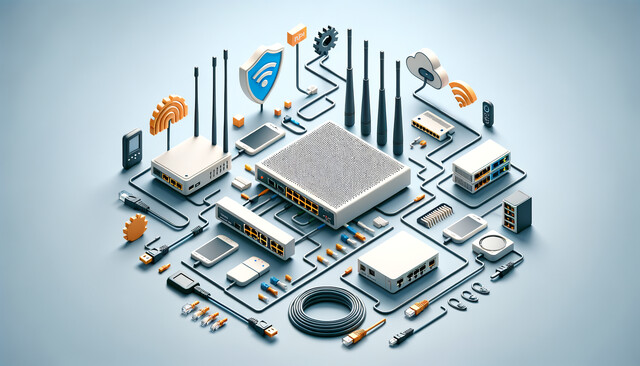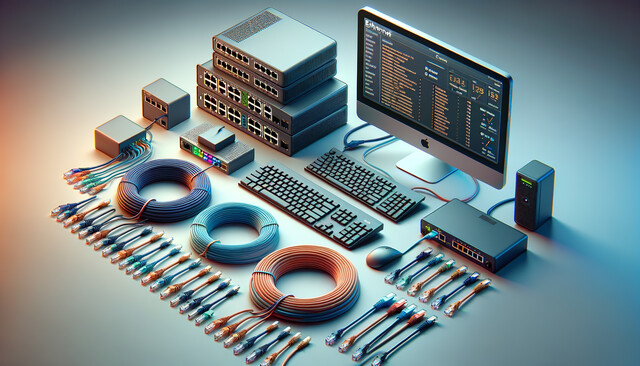Introduction to Networking Concepts
Unlock the Path to Seamless Connectivity

Step into a digital world where knowledge is power and connectivity is the key to unlocking your potential. Welcome to 'Introduction to Networking Concepts,' an essential journey that transforms novices into network connoisseurs ready to navigate, innovate, and lead in today's interconnected landscape. This course doesn't just teach networking; it immerses you in its art and science, providing the skills to build and protect the digital infrastructures of tomorrow confidently. Imagine mastering the invisible networks that connect continents and revolutionizing how businesses communicate. Elevate your career, safeguard your digital presence, and become an indispensable leader in a thriving tech space. Enroll today to embark on a path where your impact extends beyond technical knowledge, shaping the future of global connectivity. Your journey begins here.
3 Hours average completion time
0.3 CEUs
15 Lessons
22 Exams & Assignments
15 Reference Files
Mobile Friendly
Last Updated January 2025
In the digital age, where connectivity is the linchpin of personal and professional success, understanding the intricacies of networking is not just valuable--it's imperative. Welcome to "Introduction to Networking Concepts," the gateway to mastering the digital world and unlocking a plethora of opportunities in technology and beyond. This course isn't just an online class; it's a transformative journey designed to elevate your understanding of networking from foundational knowledge to real-world application.
Imagine being empowered with the ability to design, troubleshoot, and innovate in the digital networks that sustain modern life. From the smallest home network configurations to the sprawling, complex infrastructures that drive multinational corporations, the mastery of networking unlocks a universe of potential. Our course guides you through this universe with precision, clarity, and practical insight, ensuring you're not just familiar with networking concepts but are fluent in their application.
Networking is more than a technical skill; it's the art and science of building bridges in a digital world. In this course, we explore the indelible impact of networks on education, business, and global connectivity. We'll delve into the systems that connect cities, countries, and continents, and you'll uncover how these unseen infrastructures hold our world together. As you progress, you'll gain an appreciation for the elegance and complexity of network structures--from Local Area Networks (LANs) that foster communication within offices to wide-reaching Metropolitan Area Networks (MANs) that underpin entire cities.
In a rapidly evolving digital landscape, understanding networking protocols is paramount. Discover the transformative advancements in network management, as we demystify the protocols that are at the heart of digital connectivity. Our exploration of IPv6 and HTTP/3 doesn't just highlight technological evolution; it prepares you to thrive amidst the challenges of address scarcity and security, ensuring you're always a step ahead in a competitive field.
But theoretical knowledge is just the beginning. This course transforms theory into practice, equipping you with the skills to build efficient, resilient networks. You'll dive into the core mechanics of routers and switches, learning how to optimize data flow in sophisticated environments akin to orchestrating traffic in a smart city. With this knowledge, you'll be able to innovate within organizations, strategically aligning their networks to bolster productivity and foster growth.
As you gain expertise in subnetting and IP management, you'll develop a comprehensive understanding of the future-readiness of networks. You'll conquer the intricacies of IPv6 and imagine a world where digital addresses are limitless--a world you're primed to navigate and lead. The course's focus on network resilience ensures you can tackle even the most complex mergers and expansions with confidence, using advanced metrics to streamline processes and stabilize connectivity.
Of course, no discussion of networking is complete without addressing security. You'll learn how to construct a robust digital fortress, protecting vital information and ensuring the integrity of data flow in an interconnected world. This isn't merely an exercise in installing firewalls or configuring antivirus software; it's about instilling a mindset of proactive security, safeguarding your life and career in an era of cybersecurity threats.
In "Introduction to Networking Concepts," you're doing more than learning about interconnected systems--you're stepping into a role where you can influence and innovate. From understanding the backbone of the internet to employing cloud architecture for scalable solutions, the course is your passage to becoming a pivotal player in the ongoing digital revolution.
Enrolling in this course is your first step toward becoming a leader in the digital world. With practical insights, real-world applications, and an engaging journey into the heart of networking, you're investing in a skill set that is as essential as it is exciting. Seize this opportunity to not only understand the networks that connect us but to become a catalyst for the innovation and development that will shape our future. Jump in, and transform your aspirations into accomplishments with "Introduction to Networking Concepts." Your digital journey begins here.
Choose from plans starting at just $16/month (billed annually)
See Your Team Succeed
Empower your team instantly with an integrative group enrollment system. Purchase licenses in bulk with Group Discounts.




































